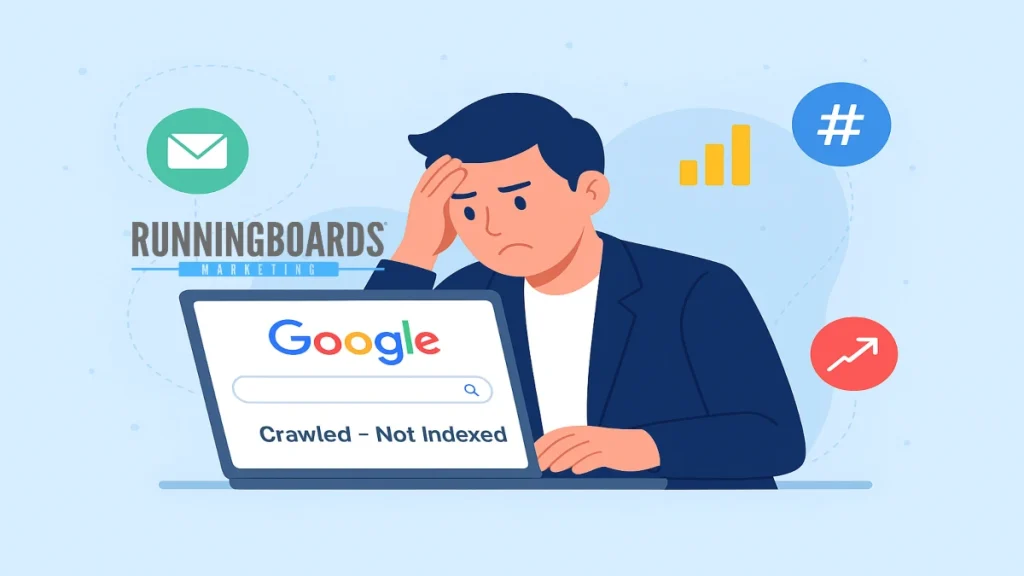On August 26, 2025, Google rolled out a major Spam Update that shook the digital marketing world. Within days, countless publishers noticed something unusual: new blog posts were being crawled but not indexed.
For marketers who rely heavily on Google Search to distribute fresh content, this has become more than a technical inconvenience—it’s a direct challenge to their ability to reach audiences, generate leads, and deliver value.

In this article, we’ll unpack what’s happening with Google right now, why your new content may not appear in search, and what practical steps marketers can take to adapt.
Why Is New Content Struggling to Get Indexed?
Normally, when you publish a new blog post, Googlebot crawls it and—if all checks out indexes it within hours or days. But since late August 2025, many site owners have reported:
- Status in Search Console: Crawled – currently not indexed
- Older content remains visible, but newer posts vanish from search results.
This isn’t necessarily a bug. Instead, it reflects Google’s evolving policy: not every page deserves to be indexed. With the Spam Update, Google is tightening quality filters, prioritizing unique, authoritative content and holding back pages it deems redundant or low-value. For marketers, this means even well-written posts may be left in limbo longer than usual.
The Marketing Challenge During Algorithm Updates
Marketers face a double bind:
- On one hand, we must keep publishing consistently to build trust and authority.
- On the other hand, our new content may not show up in search for weeks—if at all.
This creates real business risks:
- Lower organic traffic during campaigns.
- Fewer leads and conversions in the short term.
- Pressure from stakeholders who expect visibility from fresh content.
In short: when Google slows down indexing, marketing performance suffers.
Smart Marketing Strategies When Google Slows Down Indexing
So, what can marketers do while waiting for Google to stabilize? Here are some actionable strategies:
Leverage Alternative Channels
- Social Media → Share new posts on LinkedIn, X (Twitter), Instagram, or niche communities.
- Email Marketing → Notify subscribers directly—no algorithm required.
- Push Notifications → Drive repeat visits from loyal readers.
Strengthen Internal Distribution
- Add internal links from older indexed posts to your new content.
- Update evergreen articles with references to your latest insights.
Repurpose Content on Other Platforms
- Publish shorter versions on LinkedIn Articles, Medium, or Substack.
- Use them as teasers to drive readers back to your site.
These tactics ensure your work reaches people even if Google delays its recognition.
Read : Digital Mobile Billboards
Can Marketers Still Rely on Google?
The short answer: yes, but not exclusively.
Google is still the largest driver of organic traffic. Ignoring it would be a mistake. But depending solely on Google is risky, especially when algorithm changes can stall your visibility overnight.
Instead, marketers should adopt a multi-channel mindset:
- SEO remains important, but it should be one piece of a broader marketing mix.
- Balance organic search with social, paid ads, newsletters, and community engagement.
Think of Google as a powerful distribution channel, but not your only lifeline.
A Practical Guide to Navigating the Spam Update
While marketers diversify, SEO fundamentals should not be ignored. Here’s a checklist for surviving the August 2025 update:
Audit Your Content
- Is it unique, insightful, and genuinely valuable?
- Does it bring something new compared to what’s already ranking?
Fix Technical SEO
- Double-check robots.txt, canonical tags, and sitemap health.
- Ensure fast page load times and error-free rendering.
Use Google Search Console Wisely
- Submit important URLs manually.
- Monitor crawl and indexing status for anomalies.
Prioritize Evergreen & Shareable Content
- Focus on topics that remain relevant long-term.
- Use visuals, data, and storytelling to encourage sharing beyond search.
These steps won’t override Google’s indexing filters, but they’ll maximize your chances of being included once things stabilize.
Read : Grow Your Business With JFSmoney
Diversifying Traffic: Beyond Google Search
If this crisis has taught us anything, it’s the importance of not putting all our marketing eggs in one basket. Consider these alternative traffic sources:
- Social Media: Quick exposure and viral potential.
- Email Marketing: A long-term owned asset with direct reach.
- Communities & Forums: Niche groups (e.g., Reddit, Slack channels, Discord servers) where audiences actively engage.
- Paid Ads: A short-term investment to stabilize campaigns during SEO downturns.
By diversifying, marketers reduce vulnerability to Google’s unpredictable algorithm updates.
Conclusion
Google’s August 2025 Spam Update has made one thing clear: the search giant is becoming more selective about what it chooses to index. For marketers, this shift is frustrating but also a reminder to build resilient strategies that don’t depend solely on one platform.
Yes, SEO is still essential. But the future of digital marketing lies in multi-channel distribution, quality-first content, and direct audience relationships.
So while Google takes its time to decide which pages deserve visibility, smart marketers won’t sit idle. They’ll continue to create, adapt, and deliver value ensuring their content finds readers one way or another.
Pingback: Government and Education Links Again Damage Google's Ranking System - Runningboards Marketing